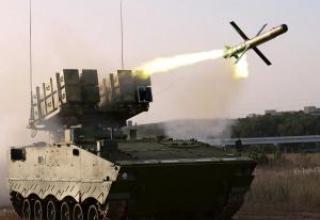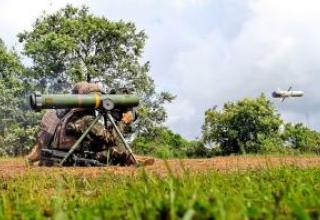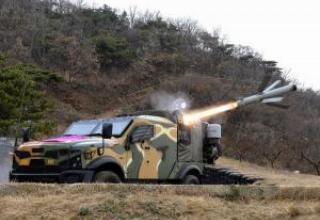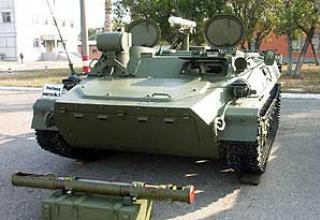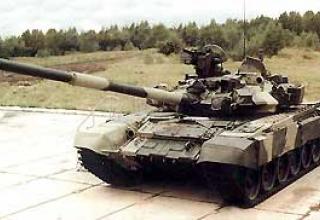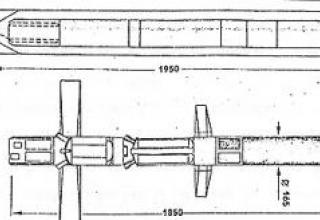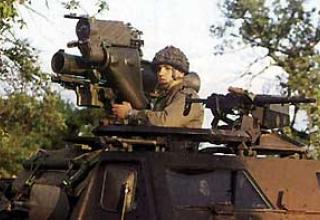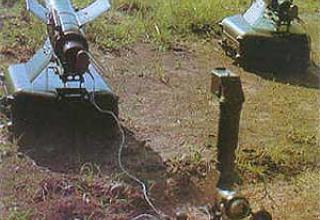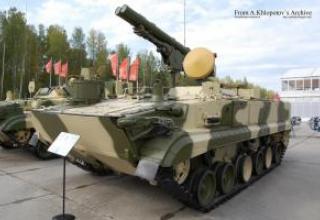
At the international exhibition of weapons and military equipment, held in early October 1992 in Athens (Greece), the Swedish company Bofors presented an anti-tank medium-range complex RBS-56 BILL.
The prerequisites for the development of the RBS-56 BILL (Bofors Infantry Light and Lethal - light infantry weapon with a high destructive power of Bofors) were the Swedish Army's requirements for arming infantry battalions with a wearable anti-tank system, which has a high destructive power when operated on modern and advanced tanks. At the same time, the developers had to take into account the trends of further development and improvement of the tanks, which were aimed at increasing the mobility and firepower of the tank, the armour protection force, as well as at increasing the protection of the most important components and ammunition.
In addition, the task was to ensure that the complex could be mounted on combat vehicles and used at any time of the day, as well as to enable effective action on helicopters in hover mode.
The high destructive power of the missile was achieved by the company not by increasing the diameter of the cumulative charge and its mass, but thanks to an unusual design and layout solution, and according to which the direction of action of the cumulative jet of the BC deviates from the longitudinal axis of the missile by 30 degrees and the trajectory of the missile when pointing it above the aiming line at 60-100 cm, thus it is possible to avoid obstacles on the ground and ensure the defeat of the tank from above.
- The implementation of the selected design and scheme solution allowed:
- to provide an opportunity to strike from the most vulnerable part of the tank - the roof of its tower or the upper armour of its hull, which is much thinner than the frontal armour;
- to increase significantly the effectiveness of the armour when acting on the frontal armour, as in this case the cumulative jet is counteracted by a much smaller layer of armour than for the armour of the existing structures (due to the increased angle of engagement);
- to significantly increase the probability of the tank being hit from the first shot due to the more destructive armour-plating action (hitting the crew, detonating ammunition, disabling devices and mechanisms), as well as due to the possibility to act on a larger target surface when attacking from above;
- providing the ability to engage targets that are in shelters when only a small part of the tank turret is visible to the gunner, and by launching missiles from behind shelters when the target is equally visible. This also increases the safety of the gunner, who is practically invisible from the target.
The chosen flight path profile of the missile eliminates the possibility of the missile colliding with natural obstacles between the gunner and the target.
The system can be installed on different types of combat vehicles and can be used both during the day and at night.
Composition:
BILL PTRK consists of three main components: a tripod-type, height-adjustable launcher, a rocket in the launch tube and a sight. The complex is portable and is designed to be serviced by 3 persons. When the firing position is changed, it can be carried by two persons (separately PP with a scope and one two missiles), for short distances it can be carried by one person. From the camping position to the combat position the complex is brought within 10-15 seconds, and after the next 5 seconds the missile can be launched. Adjustment of the sight and the launch tube along the azimuth and angle of position is carried out using two handles. The rocket is ejected from the launch tube by a gas generator, part of whose gas is taken back from the tube to reduce the recoil force. After the rocket leaves the tube the bearing planes and rudders with electromagnetic drives are opened, smoke-free marching engine is ignited. After about 100 m of flight, the fuses are detonated. In flight, the rocket acquires rotation.
The missile is equipped with an impact fuse (to detonate the BC in a direct hit) and a new BC with a non-contact fuse that reacts to a metal target and ensures that the BC is detonated when flying over the target.
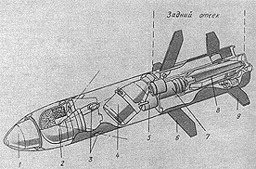
- 1.shock fuse;
- 2.marching engine;
- 3.marching engine nozzle;
- 4.Cumulative BC with non-contact fuse;
- 5.battery power;
- 6. bearing surfaces;
- 7.gyroscope;
- 8.coil for wires; 5.battery; 6.bearing surfaces; 7.gyroscope; 8.coil for wires;
- 9.steering wheels
To increase resistance to directed interference, the missiles are equipped with laser diodes as tracers with different encoded radiation for each missile. The laser diode radiation is almost impossible to suppress, and its coding, different for each missile, eliminates the mutual influence of missiles in flight and allows you to launch and guide two missiles, even if they are in sight of two sights simultaneously.
Guidance system
PTRK BILL has a semi-automatic sighting system (SACLOS) with the transfer of commands over wires, which is more advanced than other guidance systems of similar complexes. The guidance system uses a microprocessor, which uses the latest advances in signal processing. The missile is pointed at the target immediately after launch, with a high probability of hitting the target at short range and at a target moving at high speed.
Rocket with a transport and launch container
The missile of the BILL complex is located in a transport and launch container, has a length of 900 mm, body diameter 150 mm. The contact fuse and the marching engine are located at the front of the missile, the combat unit and the non-contact combined fuse occupy the central compartment. The non-contact fuse is triggered precisely as the missile passes over the target, providing maximum armor penetration of the tilted cumulated BC. The missile, together with the launch container during transport, weighs 20 kg, and in the combat position (without end-shock absorbers) - 18 kg.
In the rear part of the launch container there is an embossing propulsion system, which ejects the missile at an initial velocity of 72 m/sec. At a distance of a few meters from the operator is activated marching engine, which runs for about 2 seconds and accelerates the missile to a speed of 250 m / s. At a distance of 400 m from the PU the marching engine stops working (after fuel burnout), and the rest of the flight path the rocket flies on inertia. In flight, the missile is stabilized on the heel, with its BC directed downwards.
Training machine
From the point of view of mechanics BILL has an excellent design of a lifting starter unit which is equipped with a folding tripod, a swivel platform with hydraulic shock absorbers and a lifting handle. The tripod height can be adjusted by means of a gas-electric drive. The tripod is designed to be used from uneven ground, ensuring accurate tracking of the target. The training machine weighs 11.8 kg.
Day sight
The tracking device contains a removable day sight with an optical channel for tracking the target, which determines the deviation of the missile from the line of sight and produces corrective guidance commands, transmitted to the missile via a wired communication line. The sight also has filters for protection against laser beams, which limit the energy input into the operator's eye to a safe value. Together with protective covers the day sight has a weight of 5.9 kg, magnification - 7, field of view 110x70 mrad.
Night sight
The BILL night sight is a self-contained unit, which is mounted without any adjustment on top of the conventional day sight. The thermal image of the target is displayed in the day sight, and the crosshairs of the day sight are superimposed on it. The sight has two fields of view: wide - 16x7 with 3.2 magnification, used for search and detection of the target, and narrow - 6x3 with 8 magnification for guidance of missiles. The range of target (tank) detection is up to 2500 m, identification - up to 2000 m. The sight has two fields of view: wide - 16x7 with 3.2 magnification, used for search and detection of targets, and narrow - 6x3 with 8 magnification for guidance of missiles. Night sight with protective covers weighs 9.2 kg. The night sight is equipped with a set of accessories, which consists of 4 cylinders with compressed air and 4 batteries, placed in a special bag. Operation time of one battery and one cylinder is 2 hours.
Characteristics:
| Weight, kg: | |
| for transport with day and night scopes | 47 |
| day sights | 38 |
| on the battlefield with day and night sights | 45 |
| at gunpoint with day sights | 36 |
| missiles | 10.7 |
| PU aimed at | 15.5 |
| start-up tube | 9.8 |
| Overall dimensions of the rocket, mm | |
| diameter | 150 |
| length | 900 |
| wingspan | 410 |
| Deployment time of the complex in combat position, s | 10-15 |
| The recharging time of the complex, s | 5 |
| Maximum range of effective action, m | 2000 |
| Minimum range, m: | |
| fixed targets | 150 |
| on targets moving at 10 m/sec at a frontal speed | 300 |
| on targets moving at 15 m/sec at a frontal speed | 600 |
| Speed of rocket flight, m/s: | |
| initial | 72 |
| maximum | 250 |
| The time of flight of the rocket, s: | |
| at a distance 150m | 1.3 |
| at a distance 300m | 2.1 |
| at a distance 600m | 3.3 |
| at a distance 1000m | 5.2 |
| at a distance 2000m | 11.4 |
| Duration of work: | |
| gas generator, ms | 20 |
| marshal engine, s | 2.2 |
| Missile flight altitude above the line of sight, m | 0.6-1.0 |
| Temperature range of military application, degree C | -30...+60 |
| PTSD shelf life, years | 15 |
Testing:
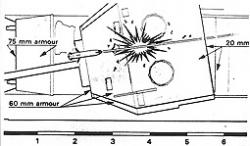
The firm conducted a series of demonstration tests of the complex for representatives of more than 20 countries in Europe, America, Asia and Africa. The Chief of Staff of the US Army was present at the tests. The action of the BILL missile on four different targets was demonstrated.
The first target was a radio-controlled tank with a tower layout made of 60 mm thick steel armour. The tank was moving at 38 km/h and was hit by the missile at a range of about 2,000 m. A combat unit detonated by a non-contact fuse at a distance of 95 cm from the obstacle broke through the frontal armour of the tower, and the armour of a cumulative jet led to the explosion of ammunition in the tank and to its sunbathing. Fragments of the tower hull destroyed the models of instruments inside the tower.
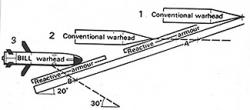
The second target - an 80 mm thick armored plate with a layer of active armor 9 mm thick - was shot (for comparison of the action) 105-mm cumulative shell and missile BILL at an angle of 20 degrees. The hardness of the steel plate HB 285. Active armour is designed to reduce the efficiency of the cumulative jet by 50-70%.
An unprotected armour plate was pierced by the 105 mm projectile, but when the projectile fired at the plate with active armour, the penetration was prevented by its action. However, the same plate with active armor was pierced by BILL rocket, because its cumulative jet was directed to the obstacle at a much larger angle of meeting, which made the jet resist a layer of 104 mm steel, while 105-mm projectile-234 mm.
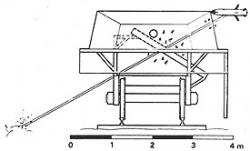
The third target was a mock-up of the tank's turret made of steel armour 20 mm thick (frontal part) and 10 mm thick (side part), inside which a steel plate 145 mm thick was placed at an angle of 30 degrees to the direction of missile flight. The target was moving on rails at a frontal speed of 35 km/h. The rocket was launched from a range of 450 m (minimum range 150 m). A cumulative jet of BC detonated by the shock fuse penetrated the 10 mm wall of the tower from a distance of 39 cm, a plate-169 cm and a 22 mm thick steel base at a distance of 312 cm from the detonation point.
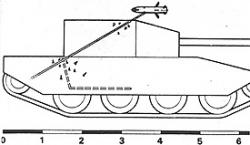
The fourth target was a model of a stationary tank in the shelter. Because of the shelter, only the upper part of the tower (less than 30%, ~ 60 cm), made of steel armour, protruded. Defeating such a target using the existing second-generation PTUR is a very difficult task. But with a BILL missile, this target was easily hit from a range of 1400 m, thanks to the missile's trajectory profile, which is 1 m above the aiming line (i.e. above the tower). In this case, the BC was detonated by a non-contact fuse that reacted only to a metal target at a distance of 65 cm from the obstacle.
Sources:
- Источники не указаны

